University Organizational Behaviour Case Study: New Zealand Factory
VerifiedAdded on 2022/11/26
|7
|1805
|177
Case Study
AI Summary
This case study analyzes workgroup behaviour within a New Zealand factory's 'water removing' section, examining the norms, group dynamics, and leadership styles present. The assignment explores the factory's environment, employee interactions, and the factors influencing their behaviour, including low wages, repetitive work, and limited interaction with management. It delves into the emergence of specific norms, such as time manipulation, smoking in restricted areas, and a warning system for supervisors, and evaluates the impact of these norms on both individual workers and the overall productivity of the factory. The analysis assesses the cohesiveness of the workgroup, highlighting both its benefits and drawbacks, and concludes with recommendations for improving performance by addressing issues like excessive interaction, time management, and the role of supervisors. The study references several academic sources to support its findings and recommendations.
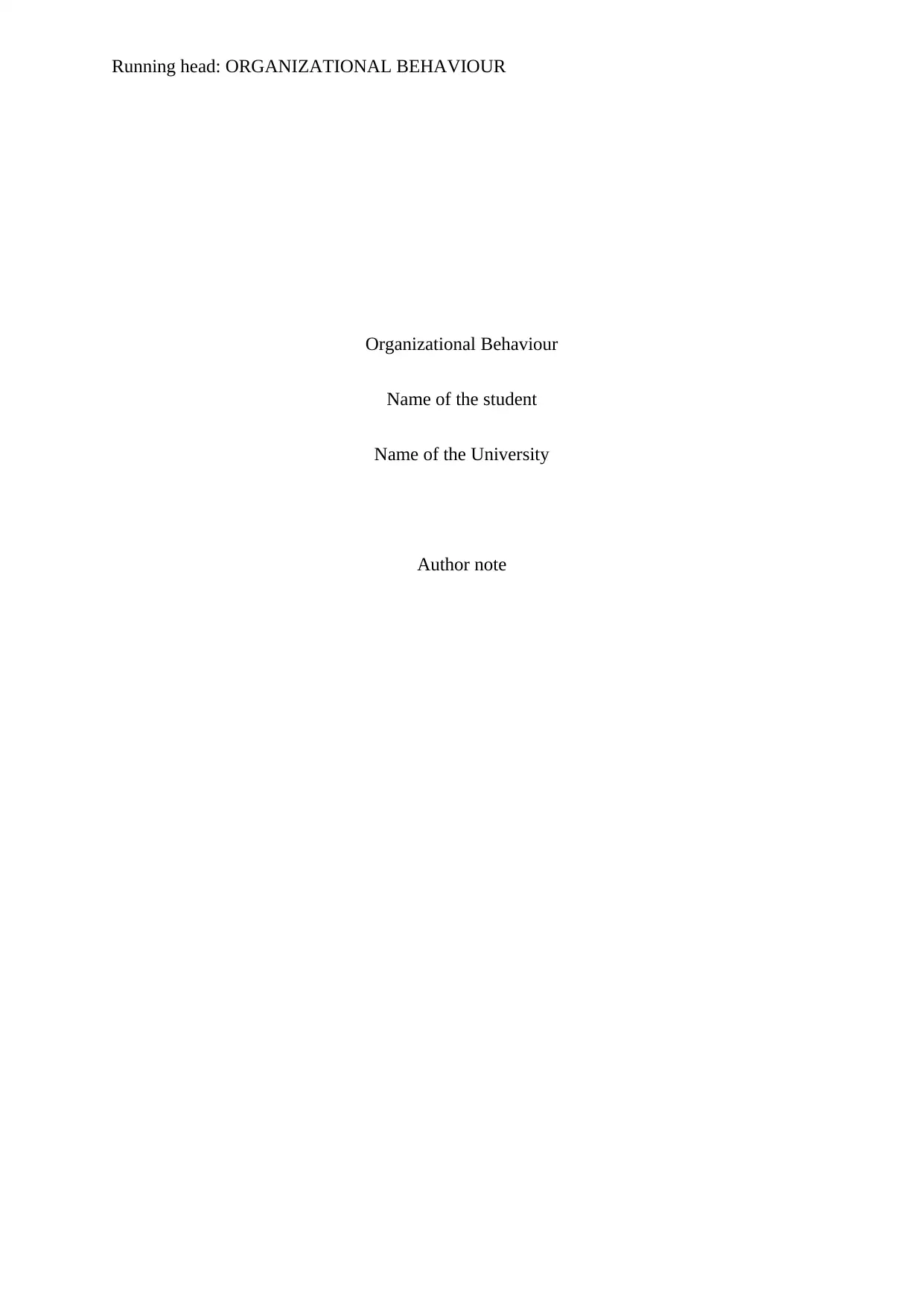
Running head: ORGANIZATIONAL BEHAVIOUR
Organizational Behaviour
Name of the student
Name of the University
Author note
Organizational Behaviour
Name of the student
Name of the University
Author note
Paraphrase This Document
Need a fresh take? Get an instant paraphrase of this document with our AI Paraphraser
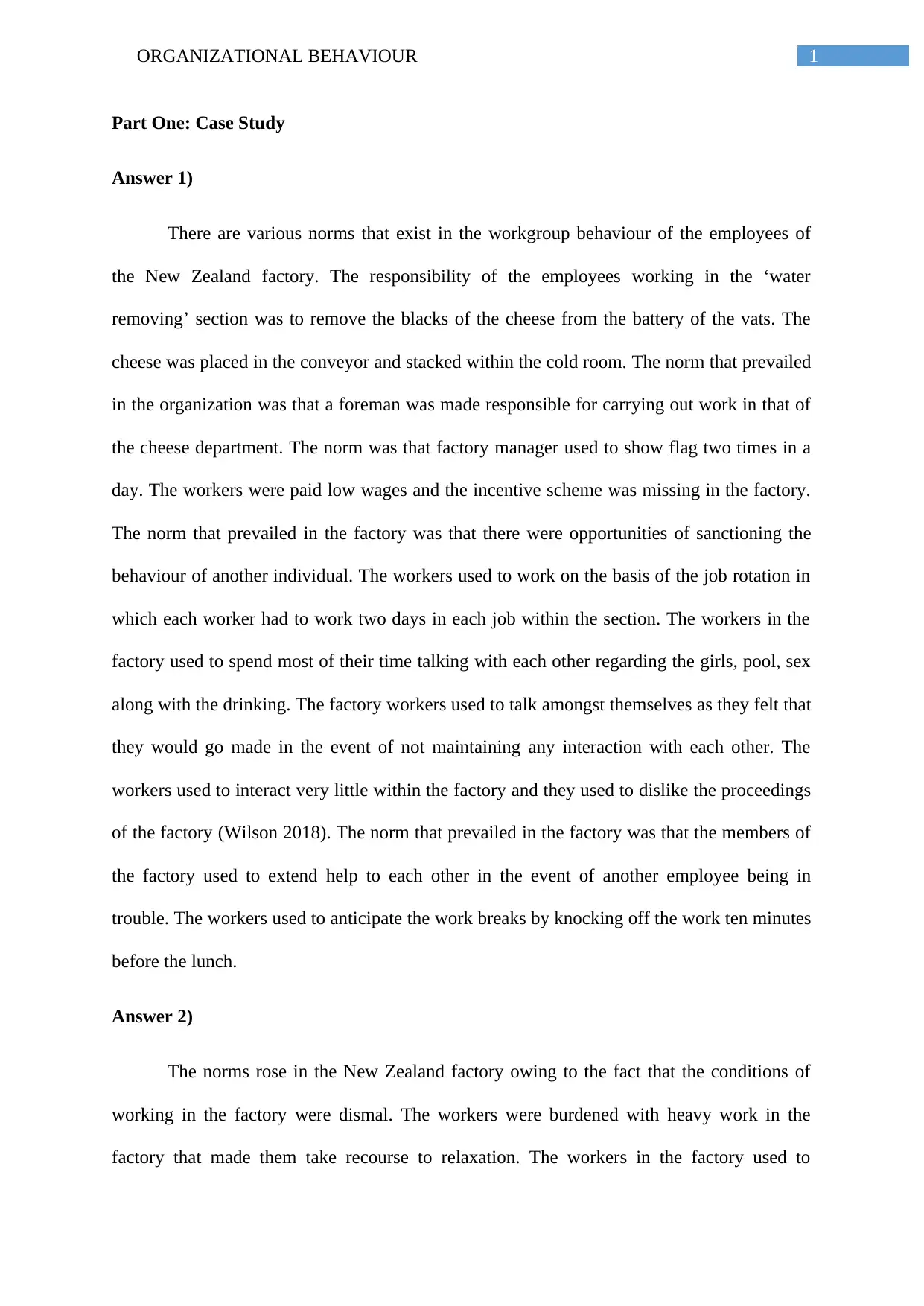
1ORGANIZATIONAL BEHAVIOUR
Part One: Case Study
Answer 1)
There are various norms that exist in the workgroup behaviour of the employees of
the New Zealand factory. The responsibility of the employees working in the ‘water
removing’ section was to remove the blacks of the cheese from the battery of the vats. The
cheese was placed in the conveyor and stacked within the cold room. The norm that prevailed
in the organization was that a foreman was made responsible for carrying out work in that of
the cheese department. The norm was that factory manager used to show flag two times in a
day. The workers were paid low wages and the incentive scheme was missing in the factory.
The norm that prevailed in the factory was that there were opportunities of sanctioning the
behaviour of another individual. The workers used to work on the basis of the job rotation in
which each worker had to work two days in each job within the section. The workers in the
factory used to spend most of their time talking with each other regarding the girls, pool, sex
along with the drinking. The factory workers used to talk amongst themselves as they felt that
they would go made in the event of not maintaining any interaction with each other. The
workers used to interact very little within the factory and they used to dislike the proceedings
of the factory (Wilson 2018). The norm that prevailed in the factory was that the members of
the factory used to extend help to each other in the event of another employee being in
trouble. The workers used to anticipate the work breaks by knocking off the work ten minutes
before the lunch.
Answer 2)
The norms rose in the New Zealand factory owing to the fact that the conditions of
working in the factory were dismal. The workers were burdened with heavy work in the
factory that made them take recourse to relaxation. The workers in the factory used to
Part One: Case Study
Answer 1)
There are various norms that exist in the workgroup behaviour of the employees of
the New Zealand factory. The responsibility of the employees working in the ‘water
removing’ section was to remove the blacks of the cheese from the battery of the vats. The
cheese was placed in the conveyor and stacked within the cold room. The norm that prevailed
in the organization was that a foreman was made responsible for carrying out work in that of
the cheese department. The norm was that factory manager used to show flag two times in a
day. The workers were paid low wages and the incentive scheme was missing in the factory.
The norm that prevailed in the factory was that there were opportunities of sanctioning the
behaviour of another individual. The workers used to work on the basis of the job rotation in
which each worker had to work two days in each job within the section. The workers in the
factory used to spend most of their time talking with each other regarding the girls, pool, sex
along with the drinking. The factory workers used to talk amongst themselves as they felt that
they would go made in the event of not maintaining any interaction with each other. The
workers used to interact very little within the factory and they used to dislike the proceedings
of the factory (Wilson 2018). The norm that prevailed in the factory was that the members of
the factory used to extend help to each other in the event of another employee being in
trouble. The workers used to anticipate the work breaks by knocking off the work ten minutes
before the lunch.
Answer 2)
The norms rose in the New Zealand factory owing to the fact that the conditions of
working in the factory were dismal. The workers were burdened with heavy work in the
factory that made them take recourse to relaxation. The workers in the factory used to
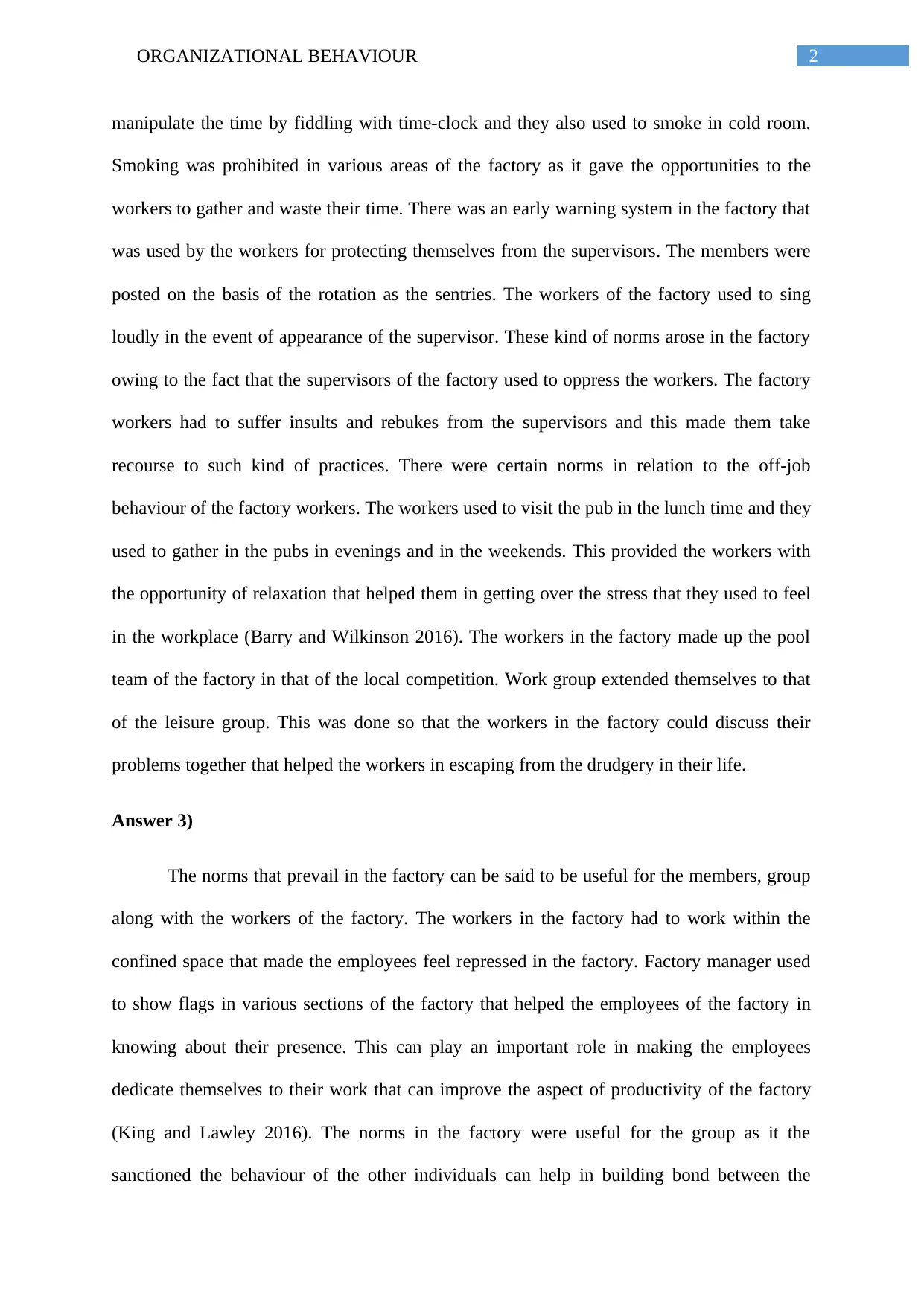
2ORGANIZATIONAL BEHAVIOUR
manipulate the time by fiddling with time-clock and they also used to smoke in cold room.
Smoking was prohibited in various areas of the factory as it gave the opportunities to the
workers to gather and waste their time. There was an early warning system in the factory that
was used by the workers for protecting themselves from the supervisors. The members were
posted on the basis of the rotation as the sentries. The workers of the factory used to sing
loudly in the event of appearance of the supervisor. These kind of norms arose in the factory
owing to the fact that the supervisors of the factory used to oppress the workers. The factory
workers had to suffer insults and rebukes from the supervisors and this made them take
recourse to such kind of practices. There were certain norms in relation to the off-job
behaviour of the factory workers. The workers used to visit the pub in the lunch time and they
used to gather in the pubs in evenings and in the weekends. This provided the workers with
the opportunity of relaxation that helped them in getting over the stress that they used to feel
in the workplace (Barry and Wilkinson 2016). The workers in the factory made up the pool
team of the factory in that of the local competition. Work group extended themselves to that
of the leisure group. This was done so that the workers in the factory could discuss their
problems together that helped the workers in escaping from the drudgery in their life.
Answer 3)
The norms that prevail in the factory can be said to be useful for the members, group
along with the workers of the factory. The workers in the factory had to work within the
confined space that made the employees feel repressed in the factory. Factory manager used
to show flags in various sections of the factory that helped the employees of the factory in
knowing about their presence. This can play an important role in making the employees
dedicate themselves to their work that can improve the aspect of productivity of the factory
(King and Lawley 2016). The norms in the factory were useful for the group as it the
sanctioned the behaviour of the other individuals can help in building bond between the
manipulate the time by fiddling with time-clock and they also used to smoke in cold room.
Smoking was prohibited in various areas of the factory as it gave the opportunities to the
workers to gather and waste their time. There was an early warning system in the factory that
was used by the workers for protecting themselves from the supervisors. The members were
posted on the basis of the rotation as the sentries. The workers of the factory used to sing
loudly in the event of appearance of the supervisor. These kind of norms arose in the factory
owing to the fact that the supervisors of the factory used to oppress the workers. The factory
workers had to suffer insults and rebukes from the supervisors and this made them take
recourse to such kind of practices. There were certain norms in relation to the off-job
behaviour of the factory workers. The workers used to visit the pub in the lunch time and they
used to gather in the pubs in evenings and in the weekends. This provided the workers with
the opportunity of relaxation that helped them in getting over the stress that they used to feel
in the workplace (Barry and Wilkinson 2016). The workers in the factory made up the pool
team of the factory in that of the local competition. Work group extended themselves to that
of the leisure group. This was done so that the workers in the factory could discuss their
problems together that helped the workers in escaping from the drudgery in their life.
Answer 3)
The norms that prevail in the factory can be said to be useful for the members, group
along with the workers of the factory. The workers in the factory had to work within the
confined space that made the employees feel repressed in the factory. Factory manager used
to show flags in various sections of the factory that helped the employees of the factory in
knowing about their presence. This can play an important role in making the employees
dedicate themselves to their work that can improve the aspect of productivity of the factory
(King and Lawley 2016). The norms in the factory were useful for the group as it the
sanctioned the behaviour of the other individuals can help in building bond between the
⊘ This is a preview!⊘
Do you want full access?
Subscribe today to unlock all pages.

Trusted by 1+ million students worldwide
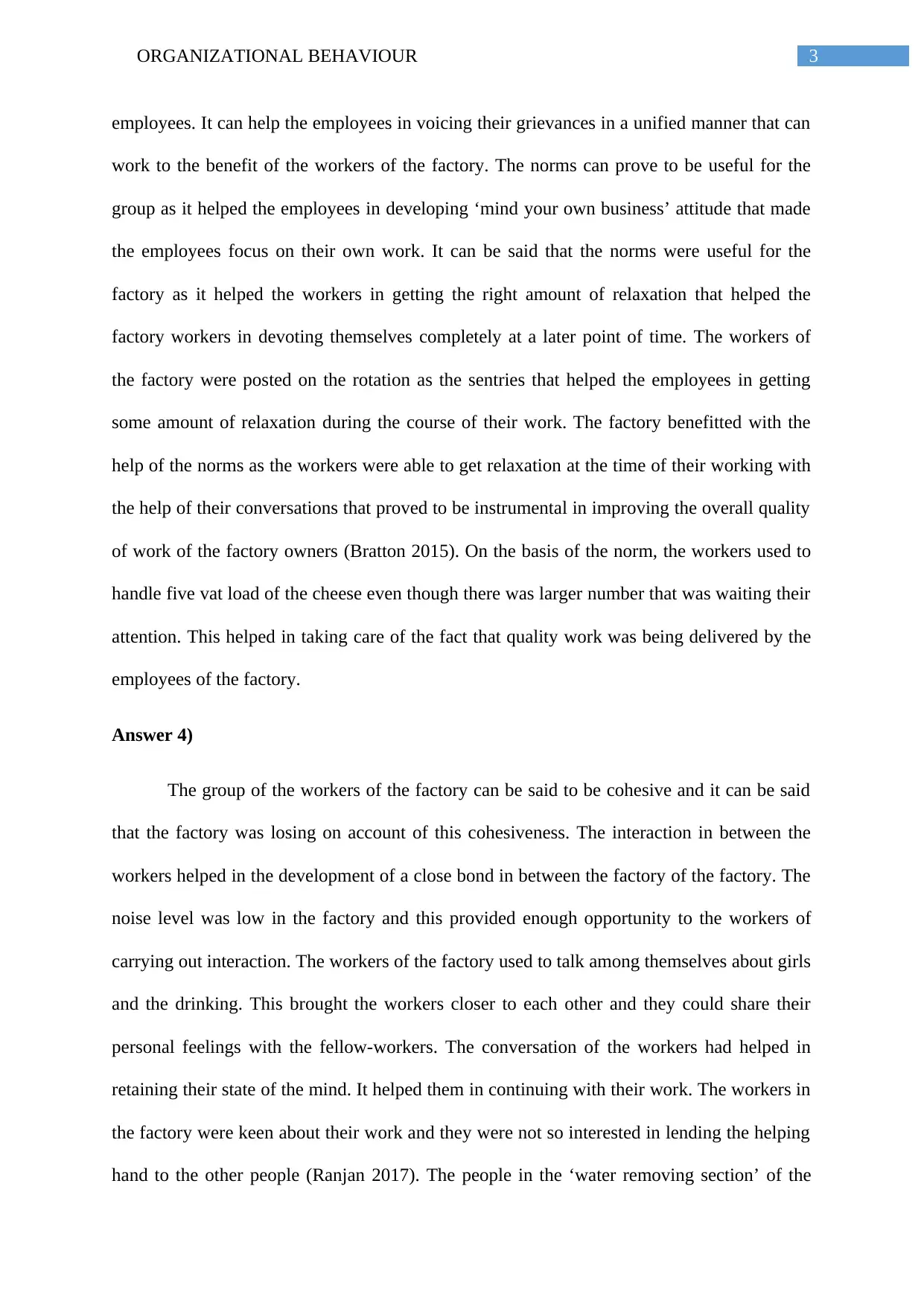
3ORGANIZATIONAL BEHAVIOUR
employees. It can help the employees in voicing their grievances in a unified manner that can
work to the benefit of the workers of the factory. The norms can prove to be useful for the
group as it helped the employees in developing ‘mind your own business’ attitude that made
the employees focus on their own work. It can be said that the norms were useful for the
factory as it helped the workers in getting the right amount of relaxation that helped the
factory workers in devoting themselves completely at a later point of time. The workers of
the factory were posted on the rotation as the sentries that helped the employees in getting
some amount of relaxation during the course of their work. The factory benefitted with the
help of the norms as the workers were able to get relaxation at the time of their working with
the help of their conversations that proved to be instrumental in improving the overall quality
of work of the factory owners (Bratton 2015). On the basis of the norm, the workers used to
handle five vat load of the cheese even though there was larger number that was waiting their
attention. This helped in taking care of the fact that quality work was being delivered by the
employees of the factory.
Answer 4)
The group of the workers of the factory can be said to be cohesive and it can be said
that the factory was losing on account of this cohesiveness. The interaction in between the
workers helped in the development of a close bond in between the factory of the factory. The
noise level was low in the factory and this provided enough opportunity to the workers of
carrying out interaction. The workers of the factory used to talk among themselves about girls
and the drinking. This brought the workers closer to each other and they could share their
personal feelings with the fellow-workers. The conversation of the workers had helped in
retaining their state of the mind. It helped them in continuing with their work. The workers in
the factory were keen about their work and they were not so interested in lending the helping
hand to the other people (Ranjan 2017). The people in the ‘water removing section’ of the
employees. It can help the employees in voicing their grievances in a unified manner that can
work to the benefit of the workers of the factory. The norms can prove to be useful for the
group as it helped the employees in developing ‘mind your own business’ attitude that made
the employees focus on their own work. It can be said that the norms were useful for the
factory as it helped the workers in getting the right amount of relaxation that helped the
factory workers in devoting themselves completely at a later point of time. The workers of
the factory were posted on the rotation as the sentries that helped the employees in getting
some amount of relaxation during the course of their work. The factory benefitted with the
help of the norms as the workers were able to get relaxation at the time of their working with
the help of their conversations that proved to be instrumental in improving the overall quality
of work of the factory owners (Bratton 2015). On the basis of the norm, the workers used to
handle five vat load of the cheese even though there was larger number that was waiting their
attention. This helped in taking care of the fact that quality work was being delivered by the
employees of the factory.
Answer 4)
The group of the workers of the factory can be said to be cohesive and it can be said
that the factory was losing on account of this cohesiveness. The interaction in between the
workers helped in the development of a close bond in between the factory of the factory. The
noise level was low in the factory and this provided enough opportunity to the workers of
carrying out interaction. The workers of the factory used to talk among themselves about girls
and the drinking. This brought the workers closer to each other and they could share their
personal feelings with the fellow-workers. The conversation of the workers had helped in
retaining their state of the mind. It helped them in continuing with their work. The workers in
the factory were keen about their work and they were not so interested in lending the helping
hand to the other people (Ranjan 2017). The people in the ‘water removing section’ of the
Paraphrase This Document
Need a fresh take? Get an instant paraphrase of this document with our AI Paraphraser
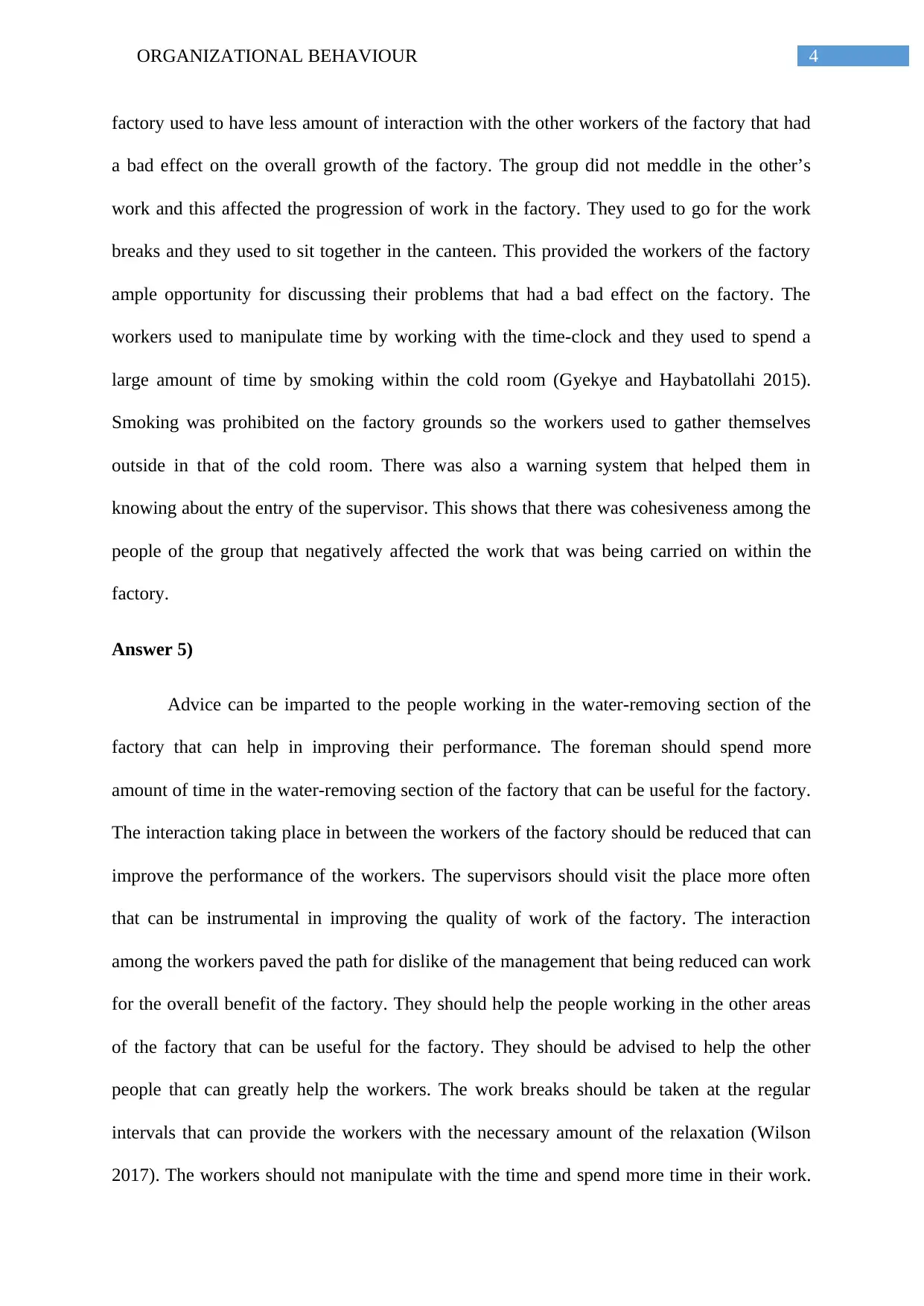
4ORGANIZATIONAL BEHAVIOUR
factory used to have less amount of interaction with the other workers of the factory that had
a bad effect on the overall growth of the factory. The group did not meddle in the other’s
work and this affected the progression of work in the factory. They used to go for the work
breaks and they used to sit together in the canteen. This provided the workers of the factory
ample opportunity for discussing their problems that had a bad effect on the factory. The
workers used to manipulate time by working with the time-clock and they used to spend a
large amount of time by smoking within the cold room (Gyekye and Haybatollahi 2015).
Smoking was prohibited on the factory grounds so the workers used to gather themselves
outside in that of the cold room. There was also a warning system that helped them in
knowing about the entry of the supervisor. This shows that there was cohesiveness among the
people of the group that negatively affected the work that was being carried on within the
factory.
Answer 5)
Advice can be imparted to the people working in the water-removing section of the
factory that can help in improving their performance. The foreman should spend more
amount of time in the water-removing section of the factory that can be useful for the factory.
The interaction taking place in between the workers of the factory should be reduced that can
improve the performance of the workers. The supervisors should visit the place more often
that can be instrumental in improving the quality of work of the factory. The interaction
among the workers paved the path for dislike of the management that being reduced can work
for the overall benefit of the factory. They should help the people working in the other areas
of the factory that can be useful for the factory. They should be advised to help the other
people that can greatly help the workers. The work breaks should be taken at the regular
intervals that can provide the workers with the necessary amount of the relaxation (Wilson
2017). The workers should not manipulate with the time and spend more time in their work.
factory used to have less amount of interaction with the other workers of the factory that had
a bad effect on the overall growth of the factory. The group did not meddle in the other’s
work and this affected the progression of work in the factory. They used to go for the work
breaks and they used to sit together in the canteen. This provided the workers of the factory
ample opportunity for discussing their problems that had a bad effect on the factory. The
workers used to manipulate time by working with the time-clock and they used to spend a
large amount of time by smoking within the cold room (Gyekye and Haybatollahi 2015).
Smoking was prohibited on the factory grounds so the workers used to gather themselves
outside in that of the cold room. There was also a warning system that helped them in
knowing about the entry of the supervisor. This shows that there was cohesiveness among the
people of the group that negatively affected the work that was being carried on within the
factory.
Answer 5)
Advice can be imparted to the people working in the water-removing section of the
factory that can help in improving their performance. The foreman should spend more
amount of time in the water-removing section of the factory that can be useful for the factory.
The interaction taking place in between the workers of the factory should be reduced that can
improve the performance of the workers. The supervisors should visit the place more often
that can be instrumental in improving the quality of work of the factory. The interaction
among the workers paved the path for dislike of the management that being reduced can work
for the overall benefit of the factory. They should help the people working in the other areas
of the factory that can be useful for the factory. They should be advised to help the other
people that can greatly help the workers. The work breaks should be taken at the regular
intervals that can provide the workers with the necessary amount of the relaxation (Wilson
2017). The workers should not manipulate with the time and spend more time in their work.
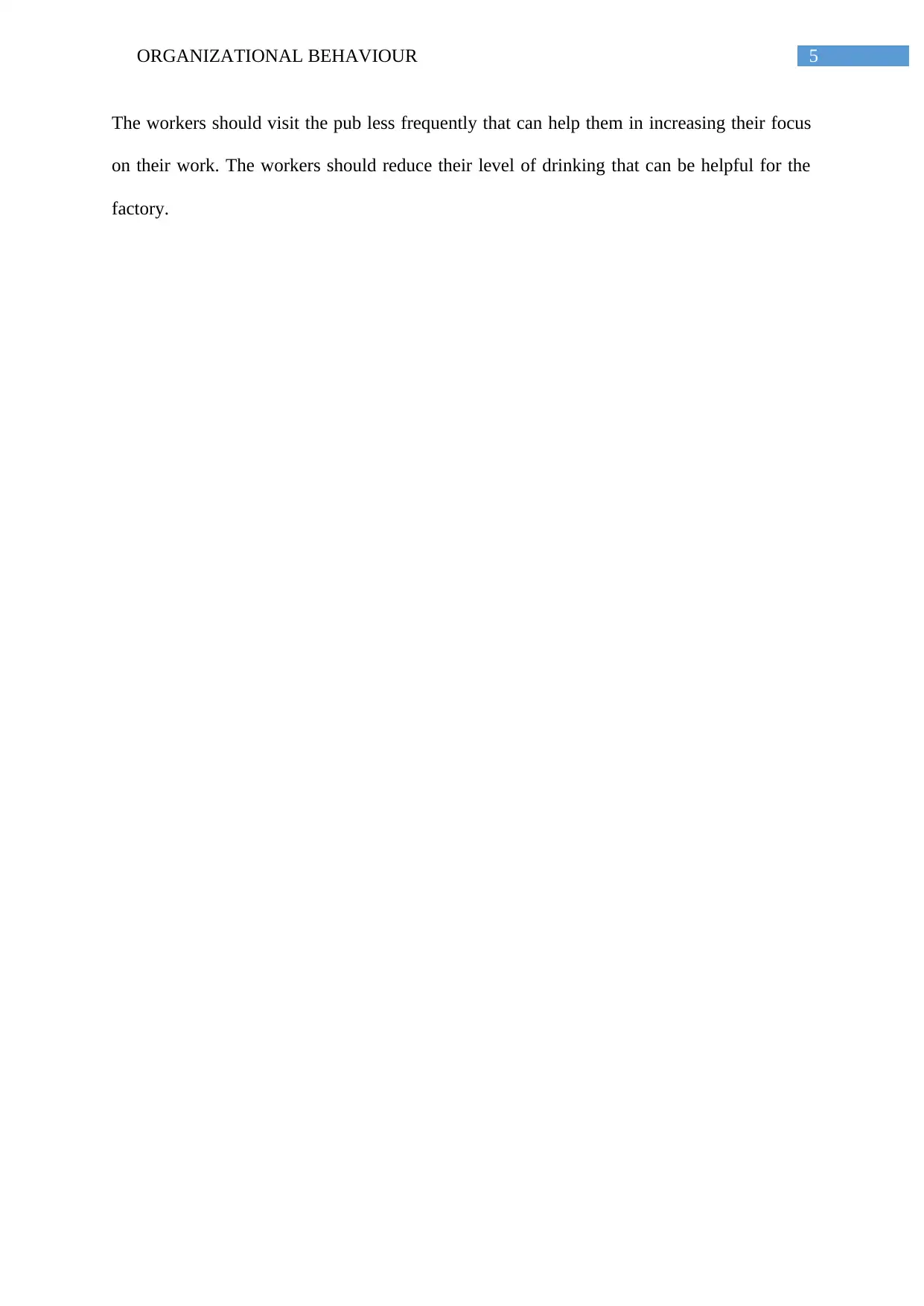
5ORGANIZATIONAL BEHAVIOUR
The workers should visit the pub less frequently that can help them in increasing their focus
on their work. The workers should reduce their level of drinking that can be helpful for the
factory.
The workers should visit the pub less frequently that can help them in increasing their focus
on their work. The workers should reduce their level of drinking that can be helpful for the
factory.
⊘ This is a preview!⊘
Do you want full access?
Subscribe today to unlock all pages.

Trusted by 1+ million students worldwide
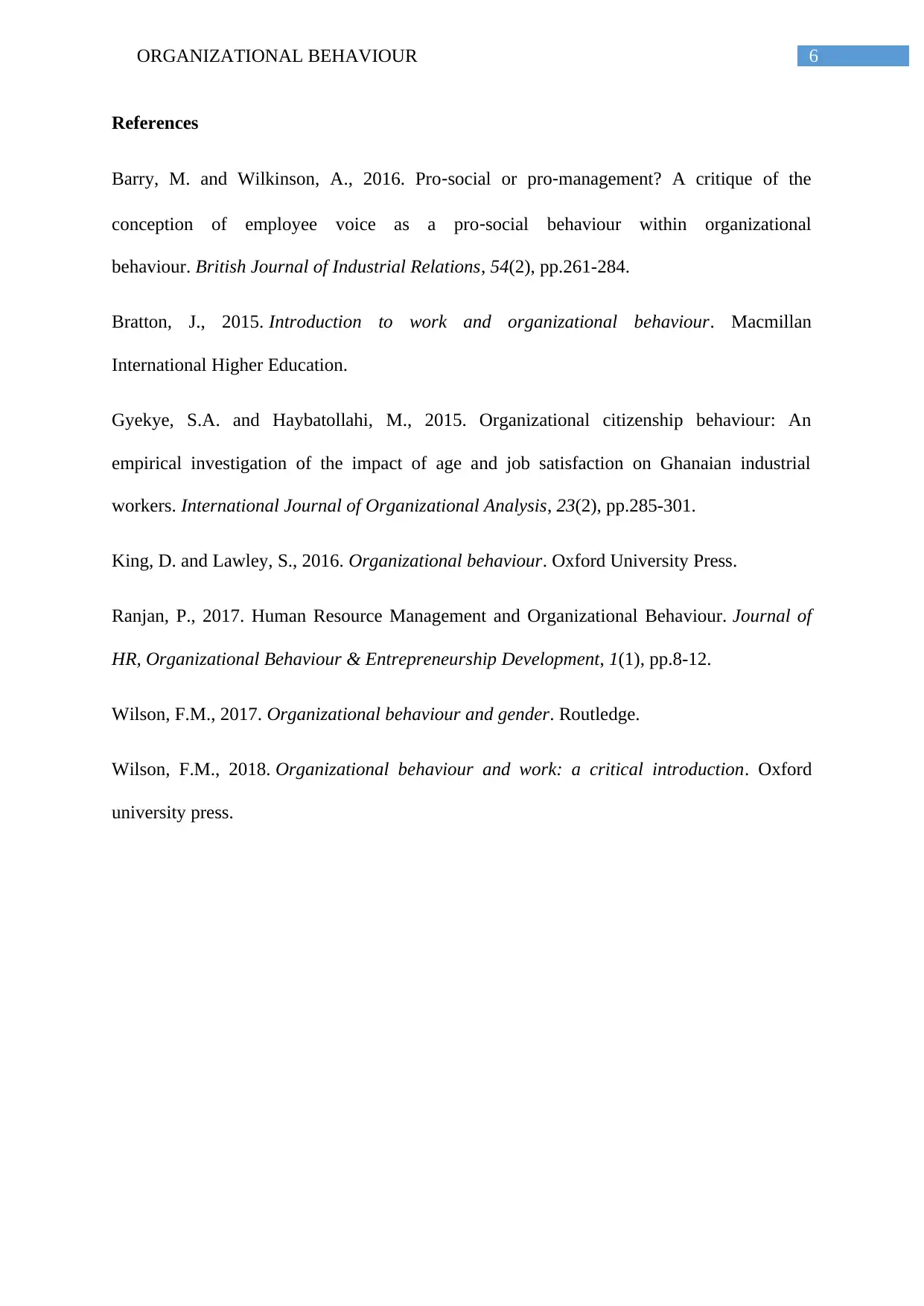
6ORGANIZATIONAL BEHAVIOUR
References
Barry, M. and Wilkinson, A., 2016. Pro‐social or pro‐management? A critique of the
conception of employee voice as a pro‐social behaviour within organizational
behaviour. British Journal of Industrial Relations, 54(2), pp.261-284.
Bratton, J., 2015. Introduction to work and organizational behaviour. Macmillan
International Higher Education.
Gyekye, S.A. and Haybatollahi, M., 2015. Organizational citizenship behaviour: An
empirical investigation of the impact of age and job satisfaction on Ghanaian industrial
workers. International Journal of Organizational Analysis, 23(2), pp.285-301.
King, D. and Lawley, S., 2016. Organizational behaviour. Oxford University Press.
Ranjan, P., 2017. Human Resource Management and Organizational Behaviour. Journal of
HR, Organizational Behaviour & Entrepreneurship Development, 1(1), pp.8-12.
Wilson, F.M., 2017. Organizational behaviour and gender. Routledge.
Wilson, F.M., 2018. Organizational behaviour and work: a critical introduction. Oxford
university press.
References
Barry, M. and Wilkinson, A., 2016. Pro‐social or pro‐management? A critique of the
conception of employee voice as a pro‐social behaviour within organizational
behaviour. British Journal of Industrial Relations, 54(2), pp.261-284.
Bratton, J., 2015. Introduction to work and organizational behaviour. Macmillan
International Higher Education.
Gyekye, S.A. and Haybatollahi, M., 2015. Organizational citizenship behaviour: An
empirical investigation of the impact of age and job satisfaction on Ghanaian industrial
workers. International Journal of Organizational Analysis, 23(2), pp.285-301.
King, D. and Lawley, S., 2016. Organizational behaviour. Oxford University Press.
Ranjan, P., 2017. Human Resource Management and Organizational Behaviour. Journal of
HR, Organizational Behaviour & Entrepreneurship Development, 1(1), pp.8-12.
Wilson, F.M., 2017. Organizational behaviour and gender. Routledge.
Wilson, F.M., 2018. Organizational behaviour and work: a critical introduction. Oxford
university press.
1 out of 7
Related Documents
Your All-in-One AI-Powered Toolkit for Academic Success.
+13062052269
info@desklib.com
Available 24*7 on WhatsApp / Email
![[object Object]](/_next/static/media/star-bottom.7253800d.svg)
Unlock your academic potential
Copyright © 2020–2025 A2Z Services. All Rights Reserved. Developed and managed by ZUCOL.




